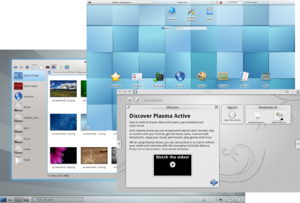KDE Plasma 4
 |
|
| Developer(s) | KDE |
|---|---|
| Initial release | January 11, 2008 |
| Stable release | 4.11.22 (19 August 2015) |
| Repository | quickgit |
| Development status | Discontinued |
| Written in | C++, QML |
| Operating system | Unix-like, Windows |
| Type | |
| License | GNU Lesser General Public License |
| Website | kde |
 |
|

Plasma Active’s Semantic File Browser
|
|
| Developer(s) | KDE, basysKom, Coherent Theory, open-slx |
|---|---|
| Initial release | October 9, 2011 |
| Stable release |
4.0 / September 5, 2013
|
| Repository | quickgit |
| Written in | C++, QML |
| Operating system | Mer, openSUSE |
| License | GPLv2 |
| Website | plasma-active |
KDE Plasma 4, subsequently renamed from KDE Plasma Workspaces, is the umbrella term for the fourth generation graphical environments provided by KDE. It consists of three workspaces, each targeting a certain platform: Plasma Desktop for traditional desktop PCs and notebooks, Plasma Netbook for netbooks, and Plasma Active for tablet PCs and similar devices.
KDE Plasma 4 was released as part of KDE Software Compilation 4 and replaced Kicker, KDesktop, and SuperKaramba, which formed the Desktop in earlier KDE releases. They are bundled as the default environment with a number of free software operating systems, such as Chakra,Kubuntu,Mageia (DVD version),openSUSE, or TrueOS.
With the release of KDE SC 4.11 on 14 August 2013, KDE Plasma 4 was placed into a feature freeze and turned into a long-term stable package until August 2015. On 15 July 2014 KDE Plasma 4’s successor, KDE Plasma 5, was released.
Plasma features containments, which are essentially applets that contain other applets. Two examples of containments are the desktop background and the taskbar. A containment can be anything the developer wants: an image (either raster graphics or an SVG image), animation, or even OpenGL. Images are most commonly used, but with Plasma the user could set any applet as the desktop background without losing functionality of the applet. This also allows for applets to be dragged between the desktop and the taskbar (two separate containments), and have a separate visualization for the more confined taskbar.
...
Wikipedia
